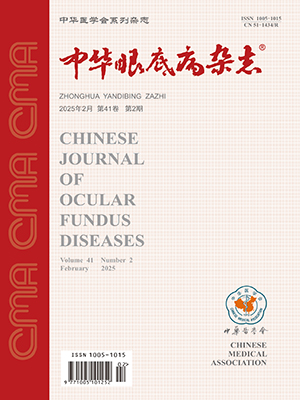| 1. |
Criswick VG, Schepens CL. Familial exudative vitreoretinopathy[J]. Am J Ophthalmol, 1969, 68(4): 578-594. DOI: 10.1016/0002-9394(69)91237-9.
|
| 2. |
Rao FQ, Cai XB, Cheng FF, et al. Mutations in LRP5, FZD4, TSPAN12, NDP, ZNF408, or KIF11 genes account for 38.7% of Chinese patients with familial exudative vitreoretinopathy[J]. Invest Ophthalmol Vis Sci, 2017, 58(5): 2623-2629. DOI: 10.1167/iovs.16-21324.
|
| 3. |
Zhang L, Zhang X, Xu H, et al. Exome sequencing revealed Notch ligand JAG1 as a novel candidate gene for familial exudative vitreoretinopathy[J]. Genet Med, 2020, 22(1): 77-84. DOI: 10.1038/s41436-019-0571-5.
|
| 4. |
陈春丽, 李筱荣. 家族性渗出性玻璃体视网膜病变的多样性研究现状[J]. 中华眼底病杂志, 2019, 35(5): 517-521. DOI: 10.3760/cma.j.issn.1005-1015.2019.05.022.Chen CL, Li XR. Diversity of familial exudative vitreoretinopathy[J]. Chin J Ocul Fundus Dis, 2019, 35(5): 517-521. DOI: 10.3760/cma.j.issn.1005-1015.2019.05.022.
|
| 5. |
Li JK, Li Y, Zhang XS, et al. Sectrum of variants in 389 Chinese probands with familial exudative vitreoretinopathy[J]. Invest Ophthalmol Vis Sci, 2018, 59(13): 5368-5381. DOI: 10.1167/iovs.17-23541.
|
| 6. |
Wang S, Zhang X, Hu Y, et al. Clinical and genetical features of probands and affected family members with familial exudative vitreoretinopathy in a large Chinese cohort[J]. Br J Ophthalmol, 2021, 105(1): 83-86. DOI: 10.1136/bjophthalmol-2019-315598.
|
| 7. |
Pendergast SD, Trese MT. Familial exudative vitreoretinopathy. Results of surgical management[J]. Ophthalmology, 1998, 105: 1015-1023. DOI: 10.1016/S0161-6420(98)96002-X.
|
| 8. |
Richards S, Aziz N, Bale S, et al. Standards and guidelines for the interpretation of sequence variants: a joint consensus recommendation of the American College of Medical Genetics and Genomics and the Association for Molecular Pathology[J]. Genet Med, 2015, 17(5): 405-424. DOI: 10.1038/gim.2015.30.
|
| 9. |
Ikeda T, Fujikado T, Tano Y, et al. Vitrectomy for rhegmatogenous or tractional retinal detachment with familial exudative vitreoretinopathy[J]. Ophthalmology, 1999, 106(6): 1081-1085. DOI: 10.1016/S0161-6420(99)90268-3.
|
| 10. |
Sızmaz S, Yonekawa Y, Trese TM. Familial exudative vitreoretinopathy[J]. Turk J Ophthalmol, 2015, 45(4): 164-168. DOI: 10.4274/tjo.67699.
|
| 11. |
Lyu J, Zhang Q, Xu Y, et al. Intravitral ranibizumab treatment for advanced familial exudative vitreoretinopathy with high vascular activity[J]. Retina, 2021, 41(9): 1976-1985. DOI: 10.1097/IAE.0000000000003122.
|
| 12. |
Kashani AH, Learned D, Nudleman E, et al. High prevalence of peripheral retinal vascular anomalies in family members of patients with familial exudative vitreoretinopathy[J]. Ophthalmology, 2014, 121(1): 262-268. DOI: 10.1016/j.ophtha.2013.08.010.
|
| 13. |
Miyakubo H, Hashimoto K, Miyakubo S. Retinal vascular pattern in familial exudative vitreoretinopathy[J]. Ophthalmology, 1984, 91(12): 1524-1530. DOI: 10.1016/s0161-6420(84)34119-7.
|
| 14. |
Ranchod TM, Ho LY, Drenser KA, et al. Clinical presentation of familial exudative vitreoretinopathy[J]. Ophthalmology, 2011, 118(10): 2070-2075. DOI: 10.1016/j.ophtha.2011.06.020.
|
| 15. |
Kashani AH, Brown KT, Chang E, et al. Diversity of retinal vascular anomalies in patients with familial exudative vitreoretinopathy[J]. Ophthalmology, 2014, 121(11): 2220-2227. DOI: 10.1016/j.ophtha.2014.05.029.
|
| 16. |
Toomes C, Bottomley HM, Scott S, et al. Spectrum and frequency of FZD4 mutations in familial exudative vitreoretinopathy[J]. Invest Ophthalmol Vis Sci, 2004, 45(7): 2083-2090. DOI: 10.1167/iovs.03-1044.
|
| 17. |
Nikopoulos K, Gilissen C, Hoischen A, et al. Next-generation sequencing of a 40 Mb linkage interval reveals TSPAN12 mutations in patients with familial exudative vitreoretinopathy[J]. Am J Hum Genet, 2010, 86(2): 240-247. DOI: 10.1016/j.ajhg.2009.12.016.
|
| 18. |
Robitaille J, MacDonald ML, Kaykas A, et al. Mutant frizzled-4 disrupts retinal angiogenesis in familial exudative vitreoretinopathy[J]. Nat Genet, 2002, 32(2): 326-330. DOI: 10.1038/ng957.
|
| 19. |
Kondo H, Kusaka S, Yoshinaga A, et al. Mutations in the TSPAN12 gene in Japanese patients with familial exudative vitreoretinopathy[J]. Am J Ophthalmol, 2011, 151(6): 1095-1100. DOI: 10.1016/j.ajo.2010.11.026.
|
| 20. |
Simunovic MP, Maberley DA. Familial exudative vitreoretinopathy mimicking macular telangiectasia type 1[J/OL]. Can J Ophthalmol, 2014, 49: e28-30[2014-02-01]. https://pubmed.ncbi.nlm.nih.gov/24513378/. DOI: 10.1016/j.jcjo.2013.11.006.
|
| 21. |
Sun W, Xiao X, Li S, et al. Germline mutations in CTNNB1 associated with syndromic FEVR or norrie disease[J]. Invest Ophthalmol Vis Sci, 2019, 60(1): 93-97. DOI: 10.1167/iovs.18-25142.
|
| 22. |
Wang Z, Chen C, Sun L, et al. Symmetry of folds in FEVR: a genotype-phenotype correlation study[J/OL]. Exp Eye Res, 2019, 186: 107720[2019-07-09]. https://pubmed.ncbi.nlm.nih.gov/31299183/. DOI: 10.1016/j.exer.2019.107720.
|
| 23. |
Salvo JS, Lyubasyuk V, Xu M, et al. Next-generation sequencing and novel variant determination in a cohort of 92 familial exudative vitreoretinopathy patients[J]. Invest Ophthalmol Vis Sci, 2015, 56: 1937-1946. DOI: 10.1167/iovs.14-16065.
|
| 24. |
Tao TC, Xu ND, Li JR, et al. Ocular features and mutation spectrum of patients with familial exudative vitreoretinopathy[J]. Invest Ophthalmol Vis Sci, 2021, 62(15): 4. DOI: 10.1167/iovs.62.15.4.
|
| 25. |
Li Y, Peng J, Li J, et al. The characteristics of digenic familial exudative vitreoretinopathy[J]. Graefe's Arch Clin Exp Ophthalmol, 2018, 256: 2149-2156. DOI: 10.1007/s00417-018-4076-8.
|




